
Intruder in the Dust is a 1948 crime novel written by American author William Faulkner. Taking place in Mississippi, it revolves around an African-American farmer accused of murdering a Caucasian man.

Intruder in the Dust is a 1948 crime novel written by American author William Faulkner. Taking place in Mississippi, it revolves around an African-American farmer accused of murdering a Caucasian man.
The novel focuses on Lucas Beauchamp, a black farmer accused of murdering a white man. He is exonerated through the efforts of black and white teenagers and a spinster from a long-established Southern family. It was written as Faulkner's response as a Southern writer to the racial problems facing the South. [ citation needed ]
Intruder in the Dust is notable for its use of stream of consciousness style of narration. The novel also includes lengthy passages on the Southern memory of the American Civil War, one of which Shelby Foote quoted in Ken Burns' 1990 documentary The Civil War .
The characters of Lucas Beauchamp and his wife, Molly, first appeared in Faulkner's collection of short fiction, Go Down, Moses . A story by Faulkner, "Lucas Beauchamp", was published in 1999.
The character Gavin Stevens appears as a protagonist in Faulkner's short story collection Knight's Gambit (1949).
Intruder in the Dust was turned into a film of the same name directed by Clarence Brown in 1949 after MGM paid film rights of $50,000 to Faulkner. The film was shot in Faulkner's home town of Oxford, Mississippi. In 1950, Faulkner was awarded the Nobel Prize for Literature for "his powerful and artistically unique contribution to the modern American novel." [1] The Nobel Prize was not specifically for his novel Intruder in the Dust but for the enduring contribution of his writing as a whole.
In her contemporary review of the novel, Eudora Welty noted its humor. [2] Dayton Kohler's 1949 article noted the book's recognition of black Americans in the American south. [3] John E. Bassett has commented that this novel represents a "serious attempt to explore contemporary Southern racism through Gavin and Chick." [4] Jean E. Graham has discussed the contrasting rhetorical styles of Gavin and Chick throughout the course of the novel. [5] Ticien Marie Sassoubre has examined the novel in the context of the social issues related to lynching in the American South, and then-recent American federal law with respect to black Americans. [6]
D. Hutchinson has elucidated the unifying literary devices of the novel. [7] Peter J. Rabinowitz analyzed Faulkner's use of the detective story in the context of the "discovery novel" as compared to Dostoyevsky. [8]

William Cuthbert Faulkner was an American writer known for his novels and short stories set in the fictional Yoknapatawpha County, based on Lafayette County, Mississippi, where Faulkner spent most of his life. A Nobel laureate, Faulkner is one of the most celebrated writers of American literature and often is considered the greatest writer of Southern literature.

Eudora Alice Welty was an American short story writer, novelist and photographer who wrote about the American South. Her novel The Optimist's Daughter won the Pulitzer Prize in 1973. Welty received numerous awards, including the Presidential Medal of Freedom and the Order of the South. She was the first living author to have her works published by the Library of America. Her house in Jackson, Mississippi has been designated as a National Historic Landmark and is open to the public as a house museum.

Light in August is a 1932 novel by American author William Faulkner. It belongs to the Southern gothic and modernist literary genres.

The Sound and the Fury is a novel by the American author William Faulkner. It employs several narrative styles, including stream of consciousness. Published in 1929, The Sound and the Fury was Faulkner's fourth novel, and was not immediately successful. In 1931, however, when Faulkner's sixth novel, Sanctuary, was published—a sensationalist story, which Faulkner later said was written only for money—The Sound and the Fury also became commercially successful, and Faulkner began to receive critical attention.
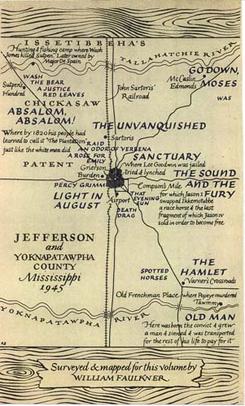
Yoknapatawpha County is a fictional Mississippi county created by the American author William Faulkner, largely based on and inspired by Lafayette County, Mississippi, and its county seat of Oxford. Faulkner often referred to Yoknapatawpha County as "my apocryphal county".
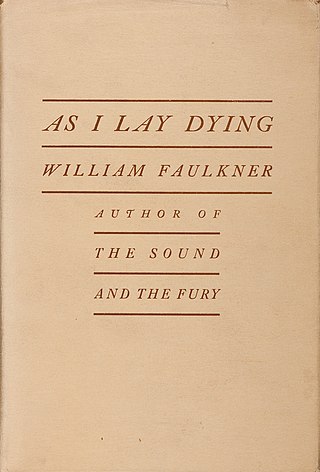
As I Lay Dying is a 1930 Southern Gothic novel by American author William Faulkner. Faulkner's fifth novel, it is consistently ranked among the best novels of the 20th century. The title is derived from William Marris's 1925 translation of Homer's Odyssey, referring to the similar themes of both works.

Go Down, Moses is a 1942 collection of seven related pieces of short fiction by American author William Faulkner, sometimes considered a novel. The most prominent character and unifying voice is that of Isaac McCaslin, "Uncle Ike", who will live to be an old man; "uncle to half a county and father to no one". Though originally published as a short story collection, Faulkner considered the book to be a novel in the same way The Unvanquished is considered a novel. Because of this, most editions no longer print "and other stories" in the title.

The Reivers: A Reminiscence, published in 1962, is the last novel by the American author William Faulkner as it was published a month before his death. The bestselling novel was awarded the Pulitzer Prize for Fiction in 1963. Faulkner previously won this award for his book A Fable, making him one of only four authors to be awarded it more than once. Unlike many of his earlier works, it is a straightforward narration and eschews the complicated literary techniques of his more well-known works. It is a picaresque novel, and as such may seem uncharacteristically lighthearted given its subject matter. For these reasons, The Reivers is often ignored by Faulkner scholars or dismissed as a lesser work. He previously had referred to writing a "Golden Book of Yoknapatawpha County" with which he would finish his literary career. It is likely that The Reivers was meant to be this "Golden Book". The Reivers was adapted into a film of the same name directed by Mark Rydell and starring Steve McQueen as Boon Hogganbeck.
The Southern Renaissance was the reinvigoration of American Southern literature in the 1920s and 1930s with the appearance of writers such as William Faulkner, Thomas Wolfe, Caroline Gordon, Margaret Mitchell, Katherine Anne Porter, Erskine Caldwell, Allen Tate, Tennessee Williams, Robert Penn Warren, and Zora Neale Hurston, among others.

A Fable is a 1954 novel written by the American author William Faulkner. He spent more than a decade and tremendous effort on it, and aspired for it to be "the best work of my life and maybe of my time". It won the Pulitzer Prize and the National Book Award. Historically, it can be seen as a precursor to Joseph Heller's Catch-22.

Juano G. Hernández was a Puerto Rican stage and film actor who was a pioneer in the African American film industry. He made his silent picture debut in The Life of General Villa, and talking picture debut in an Oscar Micheaux film, The Girl from Chicago, which was directed at black audiences. Hernández also performed in a series of dramatic roles in mainstream Hollywood movies. His participation in the film Intruder in the Dust (1949) earned him a Golden Globe Award nomination for "New Star of the Year." Later in life he returned to Puerto Rico, where he intended to make a film based on the life of Sixto Escobar.

The Mansion is a novel by the American author William Faulkner, published in 1959. It is the last in a trilogy of books about the fictional Snopes family of Mississippi, following The Hamlet and The Town.
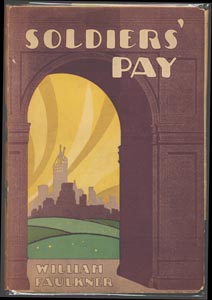
Soldiers' Pay is the first novel published by the American author William Faulkner. It was originally published by Boni & Liveright on February 25, 1926. It is unclear if Soldiers' Pay is the first novel written by Faulkner. It is however the first novel published by the author. Faulkner was working on two manuscripts while finishing Soldiers' Pay.

The University Press of Mississippi (UPM), founded in 1970, is a university press that is sponsored by the eight state universities in Mississippi, making it one of the few university presses in the United States to have more than one affiliate university.
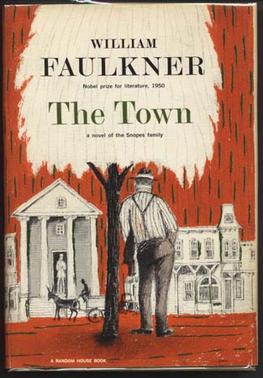
The Town is a novel by the American author William Faulkner, published in 1957, about the fictional Snopes family of Mississippi. It is the second of the "Snopes" trilogy, following The Hamlet (1940) and completed by The Mansion (1959).
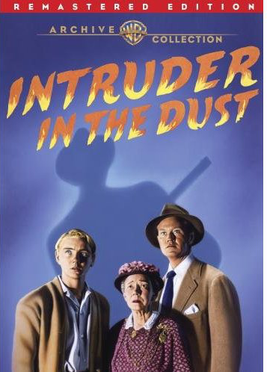
Intruder in the Dust is a 1949 crime drama film produced and directed by Clarence Brown and starring David Brian, Claude Jarman Jr. and Juano Hernandez. The film is based on the 1948 novel Intruder in the Dust by William Faulkner, and was filmed in Faulkner's hometown of Oxford, Mississippi.

William Faulkner (1897—1962) was an American writer who won the 1949 Nobel Prize in Literature. He is best known for his novels and short stories set in the fictional Yoknapatawpha County, a stand-in for his hometown of Oxford in Lafayette County, Mississippi.
Knight’s Gambit is a 1949 short story collection by American author William Faulkner. Including the titular story, the book collects six of Faulkner’s stories about attorney Gavin Stevens, who also takes a leading part in his novel Intruder in the Dust (1948).
Gavin Stevens is a lawyer and the county attorney in Jefferson in Faulkner's fictional Yoknapatawpha County, Mississippi. He was educated at Harvard and Heidelberg universities.
The literature of Mississippi, United States, includes fiction, poetry, and nonfiction. Mississippi has a literary tradition that arose from a diverse mix of cultures and races. Traditional themes from this genre of literature lean towards the past, conflict and change, and southern history in general; however, in the modern era, work have shifted towards deeply Southern works that do not rely on these traditional themes.